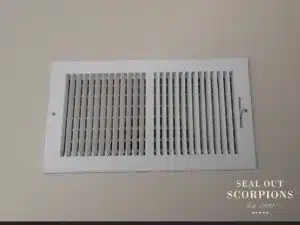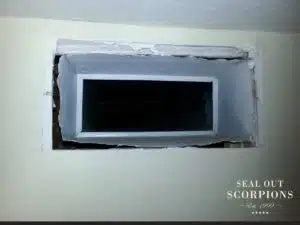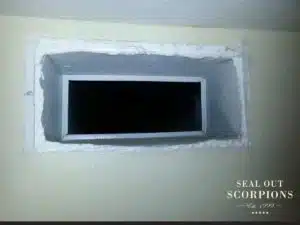Screening Your HVAC Supply Ducts – A Big Mistake for Scorpion & Pest Control!
Summary
- The Significant Downside of Screening Supply Ducts: Multiple Reasons Make It an Ill-Advised Choice.
- Screening Registers and Cover Plates Is a Futile Attempt at Scorpion Control: It’s Not Just Unnecessary; It’s Counterproductive.
- Scorpions Don’t Come Through the Supply Ducts: They Emerge from Wall Voids, it Just May Look Like They are Coming from the Duct.
- On the Rare and Unlikely Off Chance, a Scorpion Might Come Through a Duct, there’s a Bigger Problem: Screen Mesh Is Not the Solution.
- Expertise Matters: If Someone Recommends Duct Screening, What Other Misconceptions Might They Hold Regarding Building Science, Codes, HVAC Systems, and Genuine Scorpion Control?
Seal Out Scorpions Professional Advice Related to Supply Ducts & Scorpions
Don’t Screen the Duct – Seal the Gap

Don’t Take Our Word for It – Here Are the Details!
DON’T TRY TO SOLVE A SCORPION PROBLEM TO CREATE AN FUTURE HVAC PROBLEM IN THE NEXT 3-10 YEARS
Proper residential HVAC ductwork is pivotal for maintaining an optimal indoor environment, both in terms of temperature and humidity. Ductwork is like the circulatory system of the home, distributing conditioned air uniformly throughout the space. If ducts are poorly designed, installed, maintained, or airflow is improperly restricted, it can lead to temperature variations, inefficient energy usage, and poor humidity control, compromising comfort and increasing utility bills.
The science behind effective ductwork emphasizes the importance of appropriate sizing, layout, and sealing. Properly sized ducts ensure that the system can deliver the right volume of conditioned air to each room, preventing hot or cold spots. The layout should promote efficient airflow, which screening would have a negative impact on. Finally, well-sealed ducts prevent conditioned air from escaping and unconditioned air from entering the system. This also prevents scorpions from entering the duct system. Together, these principles maintain a balanced indoor environment, optimizing temperature and humidity levels for both comfort and energy efficiency, while not posing a pest control issue.
PLACING INSECT OR SCORPION SCREENS OVER ALL OR PART OF THE DUCT SYSTEM IS NOT IDEAL:
- Airflow Restriction: Screens, especially those with fine mesh, can restrict the airflow in your HVAC system. Reduced airflow can lead to decreased efficiency, making the system work harder and consume more energy. Over time, this can also put undue stress on the HVAC equipment, potentially shortening its lifespan.
- Maintenance: Screens tend to collect dust, lint, and other airborne particles over time. If not cleaned regularly, they can become a significant source of airflow restriction, mold growth, or even fire hazards.
- Supply vs. Return vs. Vent: It’s essential to distinguish between different parts of the HVAC system. While it might be appropriate to put screens on intake or fresh air returns to prevent bugs and debris from getting in, placing them on supply ducts (which blow out air) is unnecessary. Exhaust vents, especially those for dryers, can be particularly prone to lint buildup, so using a screen here could be hazardous without frequent cleaning. For Bark Scorpion control, we do screen fresh air returns, but we do not seal supply ducts or vents that would be unnecessary to seal and could pose a hazard.
- Material Matters: If you decide to use screens, ensure they’re made of materials that won’t corrode, degrade, or otherwise get damaged due to the conditions in or around the ducts.
- Scorpions Come Out of Wall Voids, not Ducts: The solution is to properly seal the open void between the duct and the drywall that is hidden behind the air register (duct cover). This is done behind the Register (duct cover).
- Professional Advice: Before making any modifications to cover you HVAC system, such as screening the ducts, you may want to consult with a local HVAC Engineer. They can provide guidance and better educated information than Technicians, or Customer Service and Sales Representatives.
Why Scorpions Don’t Come Out Of Ducts

When HVAC duct systems are properly installed and maintained, they are designed to be airtight to maximize efficiency. This sealing is primarily to ensure that conditioned air (heated or cooled) doesn’t leak out, and outside air doesn’t leak in, thus ensuring optimal performance and energy efficiency. Here’s a breakdown of the potential for bug intrusion in well-installed ducts:
- Supply Ducts: Since these channels push out conditioned air, it would be difficult for bugs to enter the living spaces through them. Properly sealed supply ducts would mean there’s a consistent outward pressure, making it unlikely for pests to get in.
- Return Ducts: These pathways draw air from living spaces back into the HVAC system. While there is an inward airflow, a well-sealed and maintained return duct shouldn’t have openings that allow bugs entry. Any breach or gap would typically be a result of damage, poor installation, or wear and tear over time.
- General Duct Sealing: Yes, ducts are supposed to be sealed to prevent air leaks up to the duct outlet or “duct terminus”. This sealing also has the secondary benefit of keeping out pests. However, ductwork can deteriorate over time or might be damaged, leading to potential gaps. Regular inspections can identify and rectify such vulnerabilities.
Scorpions and insects should not get into properly installed and sealed supply or return ducts. If there are bugs emerging from ducts, it suggests there might be a breach or gap somewhere in the system, or the source of the bugs might be elsewhere. If this were the case a qualified professional may be needed to inspect and maintain the duct running through the attic or subfloors; however, we rarely find this to be a need for bark scorpion and other pest control.
Screening The Ducts – Will It Void an HVAC Warranty?
Home warranty companies assess claims based on the terms outlined in their contracts and the specific circumstances surrounding the malfunction or breakdown. If it can be determined that the screened supply ducts contributed to or caused the HVAC issues in question, the warranty company might indeed deny the claim. Here’s why:
- Improper Alteration or Modification: Many home warranty contracts have clauses that exclude coverage for systems that have been improperly modified or altered. If screening the supply ducts is not a recommended practice or is contrary to the manufacturer’s guidelines, the warranty company might consider it an improper alteration.
- Resulting Damage: If the screening of the ducts led to restricted airflow, causing the HVAC system to work harder and subsequently malfunction or break down, the warranty company could argue that the damage was a direct result of the screens and, therefore, not covered.
- Maintenance and User Negligence: Some warranty agreements require homeowners to properly maintain their systems. If it’s determined that the screens led to reduced efficiency or caused problems due to negligence on the homeowner’s part (e.g., not cleaning the screens and allowing them to become clogged), the warranty company might deny the claim.
That said, every home warranty company and contract is different. If you to decide to screen your supply ducts or allow them to remain screened (if they already are), you may want to carefully review the terms and conditions of the specific warranty agreement. If a homeowner is concerned about potential claim down the road, they should reach out to their warranty provider to clarify their stance on such modifications before making or leaving them intact.
Types of Ducts & Vents
- HVAC Supply Duct: A conduit in an HVAC system that delivers
conditioned air from the heating or cooling unit into the living spaces, ensuring rooms reach the desired temperature.
- HVAC Return Duct: A pathway in an HVAC system that channels room air back to the heating or cooling unit for reconditioning, helping to maintain consistent indoor air quality and temperature.
- NON-HVAC Vent: An opening or passage designed to direct or expel air from specific household systems or appliances, such as fresh air fans, dryers, and stoves, ensuring proper ventilation and safety.
Our References
Authoritative Guidance on HVAC Efficiency and Best Practices, as well as Expertise on Pest Entry and Building Envelope Integrity
- ASHRAE (American Society of Heating, Refrigerating and Air-Conditioning Engineers): Renowned for industry standards and guidelines related to HVAC systems. Their insights encompass duct design, maintenance, efficient airflow, and the challenges of system obstructions.
- AZCCA (Air Conditioning Contractors of America): A significant source for manuals and guidelines detailing HVAC best practices, emphasizing ductwork sealing and proper installation.
- ENERGY STAR: Administered by the U.S. Environmental Protection Agency, this program delineates energy-efficient practices suitable for homes and businesses. Their guidelines especially focus on HVAC systems and effective duct sealing.
- BUILDING PERFORMANCE INSTITUTE (BPI): A leader in home performance and energy efficiency standards, BPI’s guidelines touch upon HVAC best practices, system optimization, and the significance of well-sealed building envelopes.
- Local Building Codes: These vary based on region and lay down specific requirements and best practices for HVAC installations, especially regarding ductwork sealing and penetrations.
- NPMA (National Pest Management Association): This association offers profound insights into the pathways pests use to infiltrate homes and suggests optimal prevention methods.
- Building Science Corporation: Renowned for their research on building construction principles, this organization underscores the importance of a correctly sealed building envelope, which is vital both for energy efficiency and pest exclusion.
Questions
Other Than Quotes







 conditioned air from the heating or cooling unit into the living spaces, ensuring rooms reach the desired temperature.
conditioned air from the heating or cooling unit into the living spaces, ensuring rooms reach the desired temperature.



